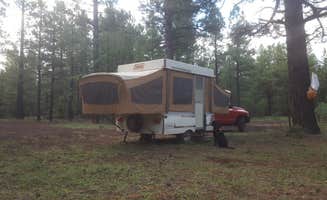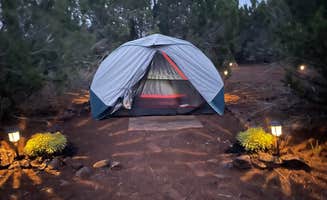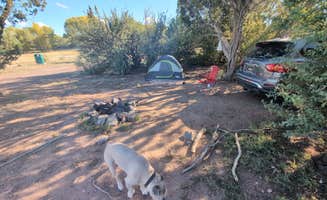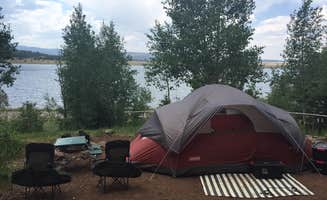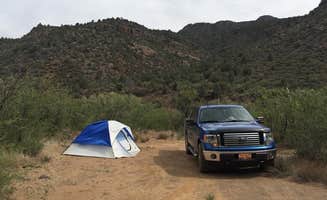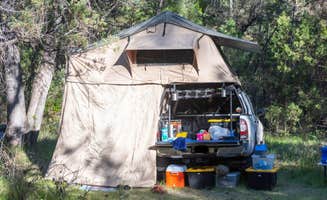Tent camping opportunities around Pinetop-Lakeside range from fully primitive to sites with basic amenities across the White Mountain region. The Apache-Sitgreaves National Forest and Apache tribal lands sit at elevations reaching 9,000 feet, creating a microclimate that experiences dramatic temperature shifts between seasons. Summer monsoon patterns typically bring afternoon thunderstorms from July through August, while fall camping features aspen color changes starting in late September.
What to do
Fishing access points: Diamond Creek Number Two Campground provides fishing opportunities in a remote setting, though visitors should note the limited signage. One visitor reported, "We followed directions via Dyrt map down Indian Rt 61. There were no signs. The road became primitive and once we reached the destination via map, still no signs."
Wildlife viewing sites: The wilderness areas surrounding these campgrounds support deer, elk, and smaller forest mammals. Campers should store food securely as bears are present in higher elevation areas. During fall, listen for elk bugling throughout the forest, especially at dawn and dusk.
Hiking trail connections: Several paths connect campgrounds to longer trail systems for day hikes through ponderosa pine forests. Pack adequate water as most trails lack reliable water sources, even during wetter seasons. The area's volcanic soil drains quickly after rain, making most paths accessible within hours after storms.
What campers like
Seclusion and privacy: Brown Creek Campground offers extremely private tent sites with minimal development. A camper notes, "If you didn't know it was here you wouldn't ever guess there was a campground. The only signage is a 'dead out' fire sign. There are very few fire rings established so plan to build your own."
Night sky viewing: The absence of light pollution creates exceptional stargazing opportunities at most sites. Brown Creek campers report exceptionally dark skies: "We went on a moonless night and it PITCH BLACK. I know it was overcast but I have to imagine with the amount of tree coverage even a clear night wouldn't be very well lit on the ground."
Convenient lake access: Shush-Be-Tou Lake Apache Indian Res provides water recreation opportunities with basic facilities including drinking water and toilets. The campground offers direct shoreline access for fishing and paddling without requiring long portages from parking areas.
What you should know
Permit requirements: Apache tribal lands require special recreation permits available at convenience stores in Pinetop or at tribal headquarters. These permits cost approximately $9-15 per day depending on activities, with separate fishing permits required.
Road conditions: Forest roads accessing the best tent camping near Pinetop-Lakeside vary significantly in quality. Most require higher clearance vehicles, though not necessarily four-wheel drive in dry conditions. Boy Creek Campground access roads become particularly challenging after heavy rainfall.
Limited facilities: Most campsites require complete self-sufficiency. A Brown Creek visitor explained, "There are no bathrooms so plan accordingly. Plenty of trees and shade. Very secluded but the roads on the way in from both Show Low and McNary were in decent shape."
Campfire regulations: Fire restrictions frequently apply from May through July depending on drought conditions. Brown Creek offers more flexibility: "It looks like they've done some logging or clearing in the area and there was plenty of down wood on the ground to use."
Tips for camping with families
Site selection strategies: When seeking the best tent camping near Pinetop-Lakeside with children, prioritize campgrounds with toilets. McCoys Bridge Apache Indian Res offers basic restrooms and drinking water, making it more suitable for families than completely undeveloped sites.
Temperature preparation: The significant elevation means temperature swings of 30-40 degrees between day and night are common. Pack warm sleeping bags even in summer, as nighttime temperatures regularly drop below 50°F.
Wildlife education opportunities: The diverse ecosystem provides excellent teaching opportunities about forest ecology. Consider bringing field guides specific to Arizona highlands to identify local plants and animals with children.
Tips from RVers
Size limitations: Bootlegger and most campgrounds in this region have significant size restrictions. Brown Creek specifically notes, "I wouldn't call this ideal for larger groups or units. There were only a few spots where I think you could have parked more than 2 tents or anything larger than a pop up camper."
Generator restrictions: Most sites prohibit generator use to preserve the quiet forest environment. Plan alternative power sources for extended stays, particularly if requiring medical equipment.
Water access points: With few sites offering hookups, RVers should fill tanks before arrival. Potable water access points exist at Bootlegger and several tribal campgrounds, though flow rates may be slow for filling large tanks.


